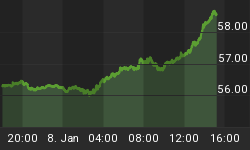Effect on Total Economy-Wide Spending from a Cut in Government Spending
Suppose that the federal government cuts its current spending on goods and services. Assuming nothing is done to tax rates, this means that the government's current borrowing will fall commensurately. (This represents a shift in the demand curve for credit, not a movement along it.) All else the same, the interest rates, with the exception of the one-day federal funds rate, which is targeted by the Federal Reserve, will decline as the demand for credit declines. At the lower interest rate structure, providers of credit other than the Fed, commercial banks, savings & loan associations and credit unions - let's call this group, non-monetary financial institutions (non-MFIs) - will decide to increase their current spending inasmuch as they are now not being rewarded as much at the margin for postponing current spending. (This reflects a movement along the demand curve for credit, not a shift in that curve.) At the lower interest rate structure, some non-government entities will decide to borrow and spend more currently. Thus, in this scenario, the decline in government spending will be offset by an increase in non-government spending. The net change in total spending in the economy will be zero. Only the composition of that spending will change. Depending on what type of federal government spending is cut and what type of non-federal government spending increases, it can be legitimately argued that future total spending could be higher than otherwise because of higher productivity growth emanating from the increase in nongovernment spending.
The outcome of a cut in current government spending on goods and services becomes more complicated when we introduce the effects on the Fed, commercial banks, savings & loan associations and credit unions - monetary financial institutions (MFIs). If the Fed keeps the one-day federal funds rate at its pre-government spending level and other interest rates fall because of the net decline in credit demand, then the marginal return of credit creation by private MFIs has decreased. As a result, there would be a net decline in the creation of non-MFI credit. In this scenario, then, there would be a net decrease in total spending in the economy by the amount of spending that had previously been financed by the MFI system. This decrease in spending resulting from the decreased lending by the private-MFI system could be prevented by the Fed. The Fed could lower the one-day federal funds rate sufficiently to restore the marginal profit from credit creation by private MFIs to its position prior to the decline in federal government spending. If the federal funds rate were already at zero, the Fed could engage in some quantitative easing in an amount equal to the decline in private MFI credit creation. In sum, whether a cut in current spending on goods and services by the federal government reduces overall spending in the economy depends critically on whether the Fed maintains total MFI credit creation. But unless the Fed increases total MFI credit to a level greater than what existed prior to the cut in current federal government spending, there will be no net increase in spending in the economy as a result of a cut in current federal government spending.
Effect on Real Economic Growth from an Energy Price Increase
Just as labor is an important input in the production of goods and services, so is energy. An increase in the price of energy reflects a relative shortage of energy from what previously was the case. Just as the price of labor can increase from an increase in demand or a decrease in supply, so, too, can the price of energy. Assume that before an increase in the price of energy, the economy was set to accelerate from 3% growth to 4% growth.
Assume that the increase in the price of energy has resulted from an increase in the demand for energy (that is, the energy demand curve is shifting out). At the higher price of energy due to increased demand, the economy will not physically be able to rise in growth from 3% to 4% that otherwise would have occurred.
Now assume that the increase in the price of energy has resulted from an interruption in supply (that is, the energy supply curve is shifting back). At the higher energy price due to a supply interruption, the economy will not physically even be able to maintain its current 3% growth, much less accelerate to 4% growth.
Paul Kasriel is the recipient of the 2006 Lawrence R. Klein Award for BlueChip Forecasting Accuracy
















